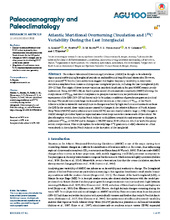| dc.contributor.author | Kessler, Augustin | |
| dc.contributor.author | Bouttes, Nathaelle | |
| dc.contributor.author | Roche, Didier M. | |
| dc.contributor.author | Ninnemann, Ulysses Silas | |
| dc.contributor.author | Galaasen, Eirik Vinje | |
| dc.contributor.author | Tjiputra, Jerry | |
| dc.date.accessioned | 2020-06-10T08:15:19Z | |
| dc.date.available | 2020-06-10T08:15:19Z | |
| dc.date.issued | 2020 | |
| dc.identifier.issn | 2572-4517 | en_US |
| dc.identifier.uri | https://hdl.handle.net/1956/22520 | |
| dc.description.abstract | The Atlantic Meridional Overturning Circulation (AMOC) is thought to be relatively vigorous and stable during Interglacial periods on multimillennial (equilibrium) timescales. However, recent proxy (δ13C benthic) reconstructions suggest that higher frequency variability in deep water circulation may have been common during some interglacial periods, including the Last Interglacial (LIG, 130–115 ka). The origin of these isotope variations and their implications for past AMOC remain poorly understood. Using iLOVECLIM, an Earth system model of intermediate complexity (EMIC) allowing the computation of urn:x-wiley:palo:media:palo20866:palo20866-math-0001 and direct comparison to proxy reconstructions, we perform a transient experiment of the LIG (125–115 ka) forced only by boundary conditions of greenhouse gases and orbital forcings. The model simulates large centennial‐scale variations in the interior urn:x-wiley:palo:media:palo20866:palo20866-math-0002 of the North Atlantic similar in timescale and amplitude to changes resolved by high‐resolution reconstructions from the LIG. In the model, these variations are caused by changes in the relative influence of North Atlantic Deep Water (NADW) and southern source water (SSW) and are closely linked to large (∼50%) changes in AMOC strength provoked by saline input and associated deep convection areas south of Greenland. We identify regions within the subpolar North Atlantic with different sensitivity and response to changes in preformed urn:x-wiley:palo:media:palo20866:palo20866-math-0003 of NADW and to changes in NADW versus SSW influence, which is useful for proxy record interpretation. This could explain the relatively large δ13C gradient (∼0.4%0) observed at ∼3 km water depth in the subpolar North Atlantic at the inception of the last glacial. | en_US |
| dc.language.iso | eng | eng |
| dc.publisher | American Geophysical Union | en_US |
| dc.rights | Attribution CC BY | eng |
| dc.rights.uri | http://creativecommons.org/licenses/by/4.0/ | eng |
| dc.title | Atlantic Meridional Overturning Circulation and δ13C Variability During the Last Interglacial | en_US |
| dc.type | Peer reviewed | |
| dc.type | Journal article | |
| dc.description.version | publishedVersion | en_US |
| dc.rights.holder | Copyright 2020 The Authors. | en_US |
| dc.source.articlenumber | e2019PA003818 | |
| dc.identifier.doi | https://doi.org/10.1029/2019pa003818 | |
| dc.identifier.cristin | 1812769 | |
| dc.source.journal | Paleoceanography and Paleoclimatology | |
| dc.source.40 | 35 | |
| dc.source.14 | 5 | |
| dc.identifier.citation | Paleoceanography and Paleoclimatology. 2020, 35 (5), e2019PA003818. | |

